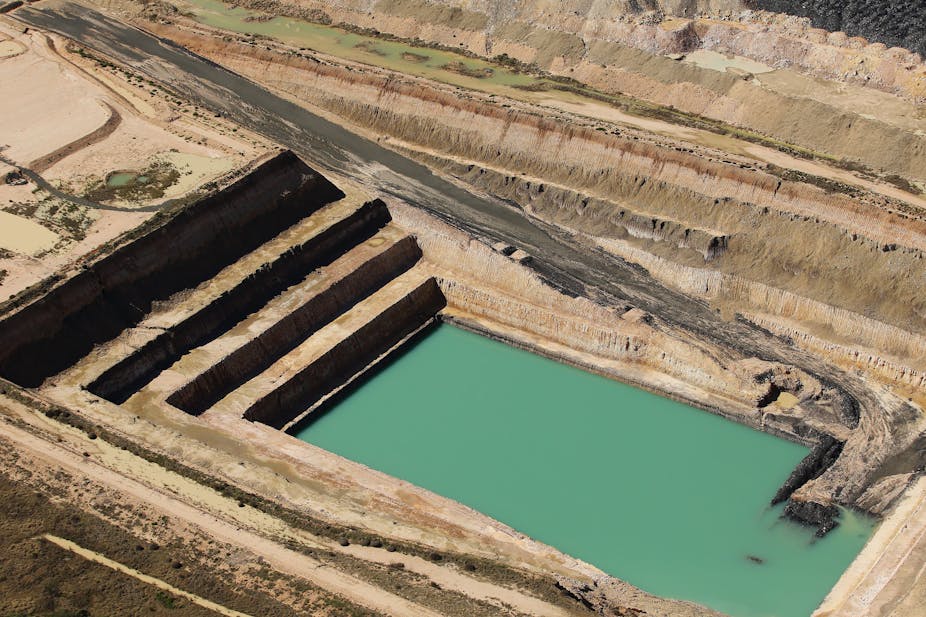The Galilee Basin is a massive Queensland coal basin on the verge of being opened up for the first time. If it goes ahead as anticipated, there will be a host of significant impacts ranging from the local to the global. But how many of us know what is being planned?
Over the last few years, several outback towns and numerous grazing properties in central-west Queensland have witnessed an unprecedented procession of coal geologists, explorers, surveyors and an associated workforce. Company vehicles and high-vis shirts can’t be missed in the usually quiet streets of the old railway towns of Alpha and Jericho. But this recent influx is only a small taste of what might come.
The Galilee Basin, covering around 250,000 square kilometres, contains vast quantities of thermal coal – the kind used for electricity generation. The coal seams come close to the surface in the north-east of the basin and that is where around nine “mega” mines are proposed to dig out the coal through both open-cut and underground extraction. Further west where the coal seams are deeper underground, explorers are busily drilling to determine the viability of coal seam gas production. Shale gas is also being sought.
Talk of coal development in the area is not new. With one of the first Galilee Basin exploration licences under his belt, the late Lang Hancock eagerly pursued potential Swedish buyers in the late 1970s and a decade later tried to secure a deal with Romanian dictator Nicolae Ceausescu. Hancock’s plans didn’t come to fruition at the time, and the “buried sunshine” lay waiting for increased demand and higher resource prices in the 21st century to renew interest in the area. This time it looks serious.
With Hancock’s daughter Gina Rinehart at the helm, Hancock Prospecting Ltd mined and exported the first coal from the Galilee Basin in 2010/11, as part of their Alpha Coal Project test-pit operation. Since then, the majority of the project has been sold to Indian conglomerate GVK. In August this year, federal Environment Minister Tony Burke deemed the project “approved with conditions”, making it the forerunner of all the proposed projects.
Part of the reason why the Galilee Basin hasn’t been mined before now is its relative remoteness. As well as a mine, the Alpha project will require the building of a new 495 kilometre rail line to Abbot Point, where the existing port will need to be expanded to handle the output from Australia’s newest coal province. From here the coal will be exported to foreign markets. So just how much coal are we talking about?
The average-sized coal mine in Queensland currently produces around 5 million tonnes (Mt) of coal every year. The Alpha Coal project would produce 30 Mt per annum, but this would not be the largest in the new basin. It is anticipated Adani’s Carmichael mine could produce around 60 Mt of coal every year, for up to 150 years. Altogether, if all the current proposed mines in the Galilee Basin go ahead, a total of more than 300 Mt of coal will be dug out of the area every year. That would amount to an increase of Queensland’s coal production by around 150%. Why be concerned?
At the local level, the proposed development of the Galilee Basin would result in serious impacts to groundwater, biodiversity and communities. The vast open-cut and underground mines would deplete groundwater, potentially affecting the region for hundreds of years. The Great Artesian Basin underlies the area being explored for coal seam gas production. Tens of thousands of hectares of remnant woodland is likely to be cleared to make way for the new mines, including areas currently set aside for conservation. Cultural and economic impacts are already being felt in the area before any of the mines have actually been developed.
The proposed new railway line has met heated opposition from some landholders, who foresee interference with the natural operation of the floodplain. And the required port expansions and inevitable increase in coal carrier traffic through the Great Barrier Reef has drawn the attention of both the Australian public as well as UNESCO.
The likely climate impacts from the opening of the Galilee Basin are both significant and are currently unaccounted for in Australia’s assessment and approval processes. If all the projects go ahead, the annual emissions from burning Galilee Basin coal would amount to around 130% of Australia’s current total annual emissions. It’s enough to make you question our governments’ commitment to cutting global emissions.
As the world population and appetite for energy continues to grow, there are many things we need to be concerned about. The opening of the Galilee Basin is one of them.
The Environmental Impact Statements for a number of Galilee Basin projects are currently open for comment.

